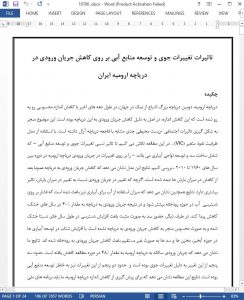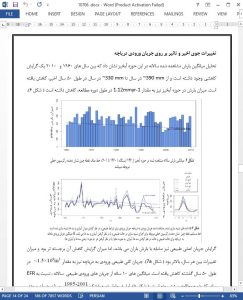Abstract
Urmia Lake, the world's second largest hypersaline lake, has decreased in size over recent decades primarily because inflow has diminished. This has caused serious socio-environmental consequences similar to those of the Aral Sea disaster. By using the variable infiltration capacity (VIC) model, this study estimates the relative contributions of climate change and water resources development, which includes the construction of reservoirs and expansion of irrigated areas, to changes in Urmia Lake inflow over the period 1960–2010. The model results show that decreases in inflow generally follow observed decreases in precipitation, although the variability in inflow is more pronounced than the variability in precipitation. The results also suggest that water use for irrigation has increased pressure on the basin's water availability and has caused flows to decrease by as much as 40% during dry years. On the other hand, the presence of reservoirs positively contributed to water availability during relatively dry years and did not significantly reduce lake inflow. By accelerating irrigation expansion in the basin, reservoirs have, however indirectly, contributed to inflow reduction. Our results show that annual inflow to Urmia Lake has dropped by 48% over the study period. About three fifths of this change was caused by climate change and about two fifths was caused by water resource development. The results of this study show that, to prevent further desiccation of Urmia Lake, it will be necessary both to develop national plans to reduce irrigation water use and to develop international plans to address climate change.
Introduction
Climate change1 significantly influences the natural hydrological cycle which can contribute to water scarcity (Haddeland et al., 2014; IPCC, 2014). To safeguard water and food supplies for growing population, humans construct reservoirs, extract water for irrigation, and modify land use. These actions have been associated with an increasing number of drying lakes in arid and semi-arid areas (IPCC, 2014). However, only a limited number of studies have assessed the role of climate change and water resources development, individually and combined, on the desiccation of lakes. This knowledge gap hampers our ability to develop adequate and effective adaptation strategies to rehabilitate and preserve endangered lakes. Among all vulnerable lakes, the saline and hypersaline lakes need particular attention due to their highly vulnerable ecosystems and the irreversible socio-environmental impacts of their desiccation. Here, we evaluate the impact of climate change and water resources development on the desiccation of the world's second largest permanent hypersaline lake, Urmia Lake (Karbassi et al., 2010).
Conclusions
Our results show that the recent Urmia Lake degradation was probably caused by reductions in river inflow into the lake due to a combination of changes in the climate and water resources development. Climate change was the main contributor to this inflow reduction. However, water resources development, particularly water use for irrigation, has played a substantial role as well. The results of this study show that urgent action is needed to rehabilitate and preserve the Urmia Lake. This urgent action should include both international action to mitigate climate change impact, and national action to improve water management, in particular to lower the consumptive water use for irrigation. It is also recommended that further studies are conducted for increasing our understanding on environmental flow requirement, the effect of the changing lake geomorphology, and the effect of groundwater extraction, as these can importantly contribute to finding a realistic solution for the Urmia Lake socioenvironmental disaster.











